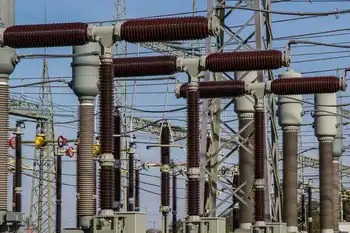Ohio To Increase Solar Energy Panel Production
By
Protective Relay Training - Basic
Our customized live online or in‑person group training can be delivered to your staff at your location.

- Live Online
- 12 hours Instructor-led
- Group Training Available
A semiconductor plant in suburban Perrysburg Township is about to get $20 million in new manufacturing equipment intended to increase capacity fivefold by 2005.
Phoenix-based First Solar LLC, which took over the project four years ago from a company backed by local inventor Harold McMaster, plans to start the project in late March. One phase will include construction of a semiconductor layer-coating and heat strengthening system by the German firm Rohwedder AG.
Besides getting new machines, the 75,000-square-foot plant, in the Cedar Business Center off State Rte. 795, will be expanded. Research offices and warehouse space are to move to the new plant from an Eckel Junction Road facility, which will be closed.
But the project has a poor history of meeting expectations and is adding capacity even as it is laying off some engineering staff. Since the project began in 1987, government agencies and private investors have pumped in more than $80 million.
Still, the investment demonstrates continued commitment to the company by owners True North Partners LLC, a Western investment group that includes Wal-Mart retailing heir John Walton. Mr. McMaster, the local founder, no longer has an ownership stake in the firm after a dispute with managers over the direction of the company and a court battle in the state of Delaware over organizational issues.
True North has pumped $58 million into First Solar since 1999, according to court documents.
The firm's lone plant in Perrysburg Township made about 30,000 panels last year and expects to double that in 2003. Still, that will be 40 percent short of capacity.
Even so, executives are confident enough of their ability to attract new customers long term that they are going ahead with the expansion plan that will increase capacity to 25 megawatts, or about 500,000 panels, annually.
First Solar doesn't sell panels for residential use, said spokesman Paula Vaughnn.
Instead, the firm focuses marketing on utilities, consultants hired to cut commercial buildings' energy use, remote areas of the world without electricity, and manufacturers of solar refrigerators and irrigation water pumps who sell their products as part of a package with solar panels.
Economic development officials at the Statehouse in Columbus and in Wood County are enthusiastic about the project because it complements their goal of promoting technology ventures and diversifying the manufacturing economy of a region dominated by the auto industry.
"First Solar is committed to coming up with a product that people will see that there is value in," said Thomas Blaha, executive director of the Wood County Economic Development Commission. Wood County granted the firm tax abatements on the equipment investment and on an expected $10 million in inventory.
The project could be the first to take advantage of a program of low-cost loans established by Gov. Bob Taft to assist companies introducing innovative new products.
The so-called Innovation Ohio fund will provide loans of up to $5 million, or 50 to 75 percent of a project's value, although state officials are unsure how much First Solar will receive. Officials of the Ohio Department of Development said the company could be eligible for training funds and tax credits for job creation.
The governor, in his state of the state address last month, cited First Solar as a poster child for state economic development programs.
Besides state assistance, First Solar and its predecessor, Toledo-based Solar Cells, Inc., have received about $1 million annually from the US Energy Department.
Executives of First Solar have told economic development officials that with the new equipment they will be ready to begin large-scale commercial production. But project backers have made such an announcement before, only to discover a glitch that forces them back to the drawing board.
First Solar spent $16 million in 2000 to build the Perrysburg Township plant. It was described as the largest solar panel production factory ever, with the capacity to produce an unheard-of 100 megawatts of solar panels annually.
But when no panels were sold 18 months later, executives acknowledged that they moved too quickly without ironing out problems in the manufacturing process. They also backed off the grandiose statements about capacity. By way of comparison, the plant will have the capacity to produce just one quarter of the originally announced 100 megawatts when the expansion project is completed.
Part of the problem is that the firm is pioneering new technology capable of producing solar modules that, although slightly less energy-efficient than traditional designs, are less labor-intensive to make. The -- as yet unrealized -- goal of advocates of so-called "thin-film" technology is to mass-produce solar modules cheaply enough to make solar power competitive with electricity made in more traditional methods.
So far, however, panels made with the new technology aren't much cheaper than traditional designs.
BP Solar announced late last year that it was closing or selling plants using the technology but would continue to make traditional panels. "While the technology continues to show promise, lack of material demand and present economics do not allow for continued investment," BP Solar said in a statement.
As a result of the announcement, First Solar is believed to be the only major firm in the world working with a particular type of thin-film technology that uses the chemical element cadmium telluride. Companies in Japan and Germany stopped using the technology in recent years, either for financial reasons or health concerns. Extensive exposure to the chemical can pose health problems, experts said.
Solar energy experts, however, downplay the risks. Robert Birkmire, director of the Institute of Energy Conversion at the University of Delaware in Newark, said users won't be exposed to the chemical because it is encapsulated in the module.
"The technology is sound and safe overall," he said.
First Solar intends to capture market share by selling modules more cheaply than competitors, said Ms. Vaughnn, the company spokesman.
Executives do not believe they are being overoptimistic about the plant's prospects. The firm supplies panels to Tucson Electric Power in Arizona and the Sacramento Municipal Utility District. But Ms. Vaughnn declined to identify other customers.
"In some cases, we are negotiating long-term supply agreements with customers who forecast demand growth over the next three years, so we feel that there is a need to increase plant capacity in order to be prepared to meet such demand," she said.
The Sacramento Utility District plans to market First Solar panels to commercial customers as a way of cutting their electricity bills. Utility official Vincent Schwent estimates that a buyer would pay about $100,000 -- including a 50 percent subsidy from the state of California -- for a solar field that would require 5,000 square feet of flat roof space and create 30 kilowatts of electricity. He estimates that, with electricity bill savings, the system would pay for itself in five years.
First Solar, which employs about 150, expects the expansion project to create jobs. In recent weeks, however, the firm laid off nine engineers and other employees.
"We determined that fewer people were needed in certain areas, which resulted in some position eliminations," Ms. Vaughnn said.
Still, local economic development boosters aren't the only people pleased with the expansion announcement.
"Everything they've been doing the past couple years has been really good," said Ken Zweibel, manager of the thin-film partnership at the US National Renewable Energy Laboratory in Golden, Colo. "They're much more organized, more precise, and have more control over their yields. They are doing well and all signals are a go."
Mr. Birkmire, of the University of Delaware, is more cautious. He praised the progress made by First Solar.
But he noted the firm will be introducing new products into a crowded market. "Overall, capacity right now is very high," he said. "In part, it's because of a huge expansion by the Japanese. Capacity is outdistancing the market."











